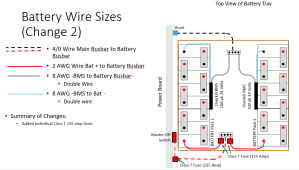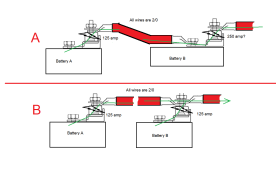benoit.letourneau@panomed
New Member
- Joined
- Nov 12, 2022
- Messages
- 20
Good Morning,
Happy new year!!!
I'm attaching 2 batteries in parallel (SOK 206ah).
I would like to put a fuse on each battery terminal. I want the bank to be fused at 250Amp. I understand I could put a 250amp fuse at the positive terminal where the wire is exiting towards my kill switch/busbar, etc (let's call that battery B). But If I want to put one on each battery, do I put a 125amp on battery A and a 250 on battery B or 125 on each? If the bank is outputting 250, each battery will be outputting 125amp. I'm thinking 125 on A and 250 on B (since it is the output of the whole bank at that point)
Not sure if my question is clear enough?
Thank you
Happy new year!!!
I'm attaching 2 batteries in parallel (SOK 206ah).
I would like to put a fuse on each battery terminal. I want the bank to be fused at 250Amp. I understand I could put a 250amp fuse at the positive terminal where the wire is exiting towards my kill switch/busbar, etc (let's call that battery B). But If I want to put one on each battery, do I put a 125amp on battery A and a 250 on battery B or 125 on each? If the bank is outputting 250, each battery will be outputting 125amp. I'm thinking 125 on A and 250 on B (since it is the output of the whole bank at that point)
Not sure if my question is clear enough?
Thank you




